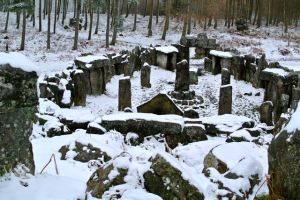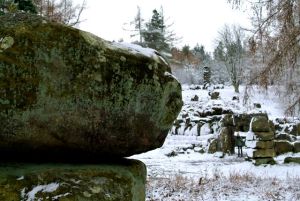This question, which has doubtless crossed the mind of many a patron over the centuries, has no obvious or straightforward answer. Follies (especially the ruined kind) rarely serve a practical purpose, apart from acting as a visually pleasing addition to the landscape, or occasionally providing a setting in which to entertain guests. Rather, a false Greek temple or a crumbling grotto ‘completed’ a view in the nineteenth century in a way that seems utterly superfluous today.
Whether as conversation pieces or as dramatic props that evoked the past within the present, the frequency of folly building during the Romantic period suggests that they were deemed in some way necessary, at least in the eyes of aristocrats and antiquarians. On rare occasions, they were even built in the name of philanthropy: William Danby paid Yorkshire locals one shilling a day to build the Druids Temple in a private forest near Masham, a project which most likely left the builders bemused but no less grateful for the paid work. That said, this is the only example I’ve come across whereby a folly emerged through an economy-stimulating exercise (I’d be interested to hear of others!).
Follies are by their very nature pointless, and yet they continue to be cherished by outdoor enthusiasts and historians alike, and are restored by heritage and conservation authorities at significant cost. Their histories (distinct from the ancient or medieval monuments that they mimic) are a reflection of the eccentricities of patrons and designers, a fascinating history in itself, but which ultimately leads no further back than the modern age. In pretending be old, antique, exotic, nostalgic or melancholic, the folly is a foible, a quirk: it japes at much older and well-respected architectural traditions.
The folly architect/designer must have at some point questioned the value in ‘forging’ antique or historical monuments in the present. Or perhaps, this remaking of the past was recognised as having an important role provoking historical interest, or in reflecting the erudition of the patron and his family. At least to some degree, follies provided a supplementary version of the past that was in some way more pleasant, familiar, accessible. There was then, as there is now, a desire to bend history to one’s will and to reconfigure events and objects in conformance with individual sensibilities and tastes. Folly building offered possibilities for re-writing history (quite literally in stone), to which newly generated myths and legends could attributed. Not only were their histories bespoke, but follies could also be custom designed for the landscapes they inhabited, optimally positioned to ensure the most optimal picturesque view. Ideal!
But how does the mythology that grows up around follies problematise actual narratives of place, and form another, parallel history? What are follies if not a material extension of the imagination – relics of a past that never truly existed outside of people’s minds? Does the fact that they are ‘fakes’ lessen their cultural or historical value? I’m interested in exploring the ways in which the architectural folly differs from the buildings and monuments that are deemed ‘authentic’, ones that are seen to have ‘real’ histories and narratives. For example, why is the Druids Temple at Masham considered to be a ‘fake’ while Stonehenge represents the authentic ‘original’ when the latter monument is equally steeped in mystery and historical speculation? (It is rumoured that Danby paid a man to live as a hermit in the temple at Masham for seven years, though he mysteriously vanished at some point during his tenancy… ). The obvious answer lies in their provenance – we know that these rock formations were arranged at different points in time – but what makes the stories and mythologies attached to each site any more or less authentic or believable? With a fresh coating of snow, it’s hard to tell a prehistoric ruin from a mock-Druid temple…
As most art and architectural historians will admit, there are few events or objects that we know absolutely everything, unequivocally, about. In fact, the opposite is often true, with many a case study caught adrift in a sea of fragmented facts, partial (subjective) descriptions and scraps of material evidence. What, then, makes a folly’s history any less legitimate or convincing, at least in terms of what the history books would have us believe? Indeed, it is often the case that the popularity of historical sites is based on how little is known about them, which allows visitors to make up their own stories as they go along. In this sense, the folly acts as a receptacle or a catalyst for new variations of history, and for the personal narratives from which they are generated. If this can be understood as a ‘function’, then perhaps the folly is not so superfluous after all.



Interesting musings…there is a folly from 1890s called Blacko Tower on Blacko Hill close to where I grew up in Lancashire. It is also the hill on which Malkin Tower stood in late 1500s early 1600s, the house/hovel of Demdyke one of the Lancashire witches.
LikeLike
Still need to get a pic of this – though nice to see it from afar!
LikeLike
Nice Blog…
On the subject of Malkin… is this the same derivation as Grey Malkin of “Macbeth” but before that of “Beware the Cat” where part of the story is based around another folly, that of Moa Cop? (& Aldersgate, London)
If you do go to Mao Cop I would also journey 30 minutes further south to Hawkstone park, which is an amazing collection of assorted follys, towers (druid) temples and ravines forming one long walk through the spectacular hills.
http://www.principal-hayley.com/ph-hotels/hawkstone-park.aspx
LikeLike
Hi Steve, sorry it took me so long to respond. Not sure about he Malkin thing but I’ll definitely add these sites to my list.
LikeLike
Just wondering, is this a folly? http://goo.gl/Szmg3
It appeared in Doctor Who this week…
LikeLike
Hmm. It’s built too look like a Gothic palace, so it is ‘mock’ in this respect. It’s hard to say what the difference is between a folly and a neomedieval building. It is, after all, a fully functioning palace with all the opulent trimmings (and that was just his ‘weekend castle’!). Perhaps its position within the landscape determines its status – set apart from other buildings that threaten to interrupt the historical illusion?
LikeLike